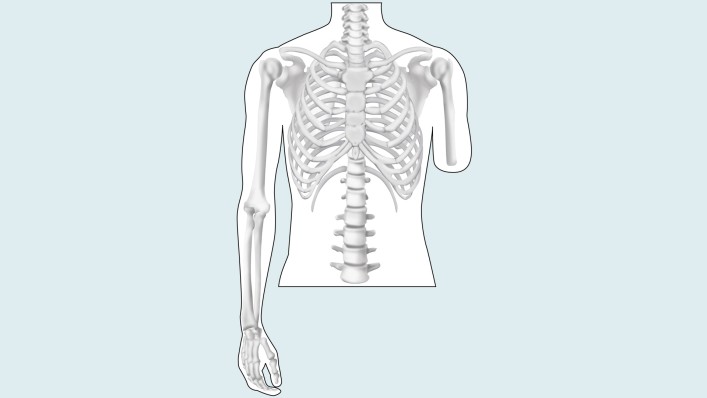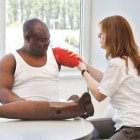Amputationlevel
What does amputation level mean?
The term amputation level is used to describe the location at which the body part is amputated. The amputation level is determined by the doctor before the operation and is based on the reason for the amputation. For planned interventions, a prosthetist is normally consulted as well in order to clarify which amputation level is suitable for subsequent fitting of the prosthesis.

Metacarpal amputation
There are many different amputation levels in the hand. They range from a digit or finger amputation, to a metacarpal amputation through the bones of the hand.
When there is less need for—or difficulty in fitting—a prosthesis that offers increased function, Cosmetic silicone prostheses are sometimes used. However, a prosthesis is not always used with the hand.

Wrist disarticulation
For transcarpal amputations, the amputation occurs through the radius and the metacarpal bones.
The prosthesis consists of a socket, which contains the residual limb, and a terminal device, which can be a hand, a hook or a Greifer. The system will also include adapters and other connecting elements. A prosthesis can be covered with a cosmetic cover so that it is hardly noticeable visually.

Transradial Amputation
For transradial (also known as ‘below elbow’) amputations, the amputation occurs through the radius and ulna of the lower arm.
The transradial prosthesis consists of a socket, which contains the residual limb (the amputated limb, colloquially referred to as the ‘stump’), the prosthetic wrist, and a terminal device, which can be a hand, a hook or a Greifer. The system will also include adapters and other connecting elements. A prosthesis can be disguised with a cosmetic cover so that it is hardly noticeable visually.

Elbow disarticulation
In elbow disarticulation surgery the elbow joint is separated and the lower arm is removed. The entire upper arm (the humerus) is maintained.
The prosthesis consists of a socket, which contains the residual limb (the amputated limb, colloquially referred to as the ‘stump’), a prosthetic elbow joint, a prosthetic wrist a terminal device, which can be a hand, a hook or a Greifer. The system will also include adapters and other connecting elements. A prosthesis can be disguised with a cosmetic cover so that it is hardly noticeable visually.

Transhumeral amputation
In a transhumeral amputation (also known as ‘above the elbow’), the amputation occurs through the upper arm bone (the humerus) , so that the elbow is no longer present.
The prosthesis consists of a socket, which contains the residual limb (the amputated limb, colloquially referred to as the ‘stump’), a prosthetic elbow joint, a prosthetic wrist joint, and a terminal device, which can be a hand, a hook or a Greifer. The system will also include adapters and other connecting elements. A prosthesis can be disguised with a cosmetic cover so that it is hardly noticeable visually.

Shoulder disarticulation
With a shoulder disarticulation shoulder disarticulation, the amputation is performed where the upper arm bone (humerus) meets the rest of the shoulder (clavicle and scapula).
The prosthesis consists of a socket, which contains the residuum (in this case the scapula and clavicle and upper portion of the trunk), a prosthetic shoulder joint, a prosthetic elbow joint, a prosthetic wrist joint, and a terminal device, which can be a hand, a hook or a Greifer. The system will also include adapters and other connecting elements. A prosthesis can be disguised with a cosmetic cover so that it is hardly noticeable visually.

Forequarter (or ‘Intrascapular Thoracic’) amputation
With a forequarter amputation, the upper arm bone (humerus) scapula, and clavicle, are all removed.
The prosthesis consists of a socket, which contains the residuum (in this case the upper portion of the trunk, including the ribs), a prosthetic shoulder joint, a prosthetic elbow joint, a prosthetic wrist joint, and a terminal device, which can be a hand, a hook or a Greifer. The system will also include adapters and other connecting elements. A prosthesis can be disguised with a cosmetic cover so that it is hardly noticeable visually.


